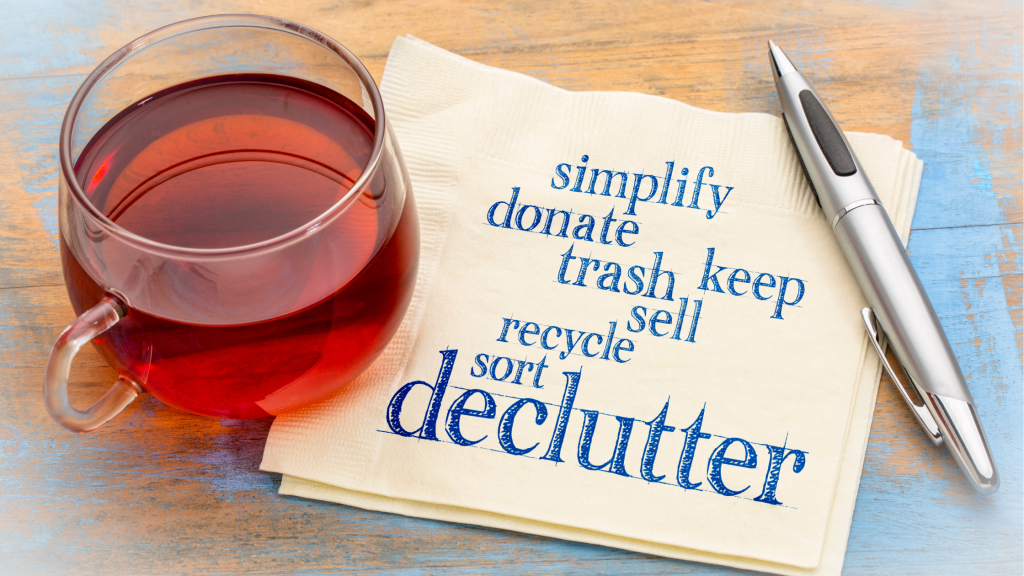Often we accumulate an excess of things without even realizing it because, at the time, it’s just a “must-have” cute sweater, or a birthday gift from a friend, or a new innovative tech gadget that we have to have. Unfortunately, that sweater enters a closet filled with old “must-have” clothes, and that old tech gadget too often gets tossed in a drawer to be dealt with later. Before you know it, your home is overrun with stuff you don’t need, and the thought of decluttering can feel completely overwhelming. Following these five tips for decluttering can help you know where to start and help you get your space to a place that gives you peace, not overwhelming anxiety.
- If You Don’t Use it, Get Rid of it!
We all have things in our homes that we don’t use; it’s inevitable. Often those unneeded things linger around much longer than they should; It’s easy to forget about them or tell ourselves that we may use them “someday” and store them even longer. In the end, causing ourselves countless hours of wasted time organizing items we don’t need and taking up valuable space in our home to store them, this seems like a lose-lose to me. One of my favorite ways to start decluttering any space is with the “Four-Box method.” To complete this method, you will need four boxes, and you will need to label them: Trash, Give Away, Keep, or Re-locate. Picking one room at a time, you can place all the items from this room into one of the four boxes. Try not to leave any item out, no matter how small or insignificant it may seem. You may be shocked how quickly you can cut down the amount of stuff in your home.
- Make Sure That Everything Has a Place
If something doesn’t have a home, it’s time to either make it a home or get rid of it! This theory is arguably one of the best decluttering tools to refer back to as often as possible. Clutter is usually caused by a failure to return things to where they belong; If that thing doesn’t have a home and you can’t discard it, then it will always be out of place and cluttering up your space.
- Pantry Decluttering
If you’re not sure where to start, the pantry is always a great choice. Pull all the contents of the pantry out so that you are starting fresh. Make sure to remove and throw out any expired items. Then set aside any unwanted items to donate to your local food bank or someone you know in need. Once you have cleared out all unwanted items and wiped down your shelves, it’s time to put the remaining items back into the pantry. By decluttering the things that have expired or that you won’t use, you can maximize the space that you do have. You will want to group similar items together by type, making them easier to find in the future and make sure you put your foods that will expire earliest at the front. You can also utilize many different storage options when it comes to your pantry. Wire shelving can help you use vertical space, or wall hooks can help maximize wall space. This task does not have to be done all at one time. You can always tackle it one shelf at a time if you work better in shorter intervals.
- Try the Box in, Box out or Tape Methods
As already suggested above, the beginning process of all spaces should be similar, doing a sweep and donating, selling, or throwing out any items that you already know you don’t use. With the “box in, box out” method, once you have removed all unwanted items, place the utensils remaining in your kitchen into a box and decide on a time frame. When I used this method in my home, I decided on a one-month time frame; If I didn’t use it in a month, I didn’t need it. (This timeline may vary for you depending on how often you’re actively using your kitchen.) At the end of the month, I donated all the remaining utensils in the box, minus a couple of seasonal items that I knew I would need come turkey time, of course! I have also tried the tape method in other areas of my home, and I loved the result. With the tape method, you will place a small piece of masking tape on each item and only remove the tape when you use the item. At the end of the month (or whatever time frame you established for yourself), anything that still has tape attached can be donated or thrown out.
- Managing Your Overloaded Closet
We should treat our closet like any other space; Your first step should always be to remove things you know you don’t want. Once you have removed these items, you can move on and try the hanger trick! A method similar to the box and tape methods, just this time, you’re using hangers to help narrow down the clothes you don’t wear. Turn all your clothes hanging in your closet around so that the hangers are facing back-to-front. For the next six months, when you wear an item of clothing, return it to the closet with the hanger facing the correct way. You should consider donating any clothing on hangers that are still hung back-to-front at the end of six months since if you haven’t worn them.
Decluttering can take some time. We don’t generally accumulate all this excess stuff overnight. So we shouldn’t expect to get rid of it overnight either. If you have items that don’t have a place in your home but you’re not ready to get rid of yet, feel free to contact our friends at Crate It Storage to help you find a storage solution that works for you!

